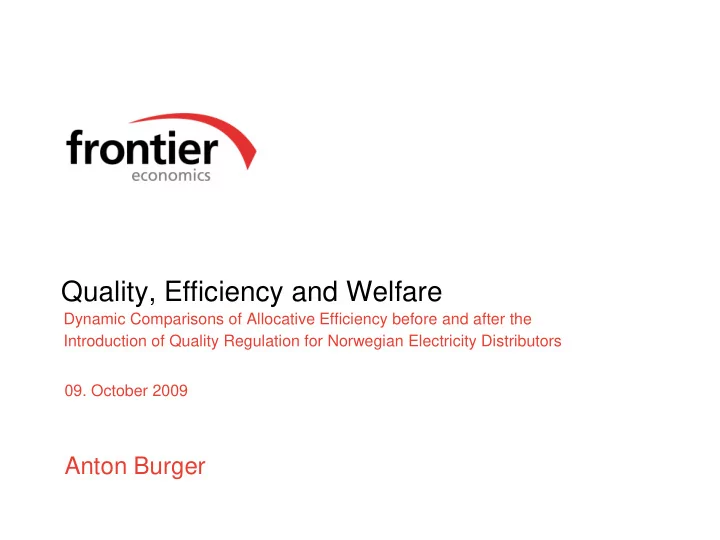

Quality, Efficiency and Welfare Dynamic Comparisons of Allocative Efficiency before and after the Introduction of Quality Regulation for Norwegian Electricity Distributors 09. October 2009 Anton Burger
● Introduction and Motivation ● Methodology ● Results ● Conclusion Frontier Economics 2
Introduction Regulation, efficiency and quality ● cost plus regulation leads to low efficiencies, but reasonable quality price cap and direct quality incentives ● high powered schemes lead to more efficiency ● but the incentives to cut costs lead efficiency quality to quality problems in the long run ● more quality can be achieved by: □ back to cost-plus elements □ direct quality incentives ● Sappington 2005: partial cost- price pass- ”By specifying service quality targets plus cap through and associated penalties and bonuses, a regulator can induce the regulated firm to employ its superior low powered high powered cost information to achieve desirable incentives incentives levels of service quality” Frontier Economics 3
Introduction Motivation Why this study and why in Norway? ● no empirical evidence so far that considers cost and quality in conjunction ● Norway serves as a policy experiment ● since 1997 price cap regulation ● since 2001 explicit quality incentives Quelle: NVA, in MWh …outages were indeed reduced, but was it worth it? Frontier Economics 4
● Motivation ● Methodology ● Results ● Conclusion Frontier Economics 5
Quality Increase has 2 Effects on Total Surplus Welfare Effects Gross Welfare ● willingness to pay (and social costs of thereby welfare) of an industry every customer increases if quality rises ● framework allows for an effect in addition to pure costs of outages outage monetay trade off costs costs … can one verify that empirically? Frontier Economics 6
Gross Welfare – the easier Part D’ D increase in welfare because of more quality ● Assumptions: □ More Qualiity is valued more by ALL Customers (as opposed to product differentiation) Q ↑ D ↑ □ No Quality Discrimination (otherwise Mussa – Rosen Model) price quantity more quality ● If quantities stay constant or at least decrease in the right ratio to always the increased quality, gross welfare at least did not decrease (in increases more detail in the Paper) gross Welfare Frontier Economics 7
Social Costs of an Industry A standard cost minimization problem Social costs of an industry A piecewise - linear convex hull around the observed data ● OC/OA – overall efficiency ● OB/OA – technical efficiency Firm at t+1 D monetary costs Firm at t ● OC/OB – allocative efficiency E A F B ● (OD/OF) / (OA/OC) – Cost Malmquist C Index – the relative change in overall Priceline costs between two points in time O energy not supplied Frontier Economics 8
Intertemporal Comparisons with Malmquist Indices The change in Overall Efficiency is disentangled into all four possible reasons. (Maniadakis und Thanassoulis (2004)) Frontier Economics 9
3 Hypothesis ● After the introduction of quality regulation, the social cost of electricity distribution decreased. By referring to our welfare framework, this Hypothesis 1 means that welfare increased. ● tested by ⇒ Cost Malmquist Index ● The decrease of the social costs and the increase in quality are due to the new regulation regime in that, firms were induced to substitute Hypothesis 2 costs for outages in a socially more favourable manner. ● tested by ⇒ Δ Allocative Efficiency ● Quality was too low from a welfare point of view before the Hypothesis 3 introduction of quality regulation as the improvement in quality had a Corollary positive welfare effect. Frontier Economics 10
● Motivation ● Methodology ● Results ● Conclusion Frontier Economics 11
Results Model Setup ● three outputs □ number of clients □ MWh transmitted □ network length ● two inputs □ TOTEX = OPEX + CAPEX (we would measure no Averch Johnson Effect) □ energy not delivered – ENS Unwanted outputs can be used as inputs. ● price data □ price of one unit of money = 1 □ price of ENS = app. 4-6 EURO per KWh The price of one unit of money is one ● 50 DSOs, 31 had data from 1999 to 2005 Frontier Economics 12
Results Frontier Economics 13
● Motivation ● Methodology ● Results ● Conclusion Frontier Economics 14
Conclusion What we did: ● We derived sufficient conditions for a welfare increase and tested them empirically □ Social costs of providing electricity distribution were decreased ● Our Malmquist analysis filtered out the main reason for the decrease in social costs ⇒ better input mix What can you learn from that when it comes to regulation? ● The product quality in the pure price cap regime was apparently too low □ Otherwise we would not have seen an increase in welfare ● Direct incentives can not only increase quality, but also welfare and this can be tested. ● Methodology: DEA analysis in a welfare context; dynamic comparisons of technical AND allocative efficiency Frontier Economics 15
Frontier Economics Limited in Europe is a member of the Frontier Economics network, which consists of separate companies based in Europe (Brussels, Cologne, London and Madrid) and Australia (Melbourne & Sydney). The companies are independently owned, and legal commitments entered into by any one company do not impose any obligations on other companies in the network. All views expressed in this document are the views of Frontier Economics Limited. Frontier Economics 16
FRONTIER ECONOMICS EUROPE LTD. BRUSSELS | COLOGNE | LONDON | MADRID Frontier Economics Ltd, 71 High Holborn, London, WC1V 6DA Tel. +44 (0)20 7031 7000 Fax. +44 (0)20 7031 7001 www.frontier-economics.com Frontier Economics 17
Recommend
More recommend